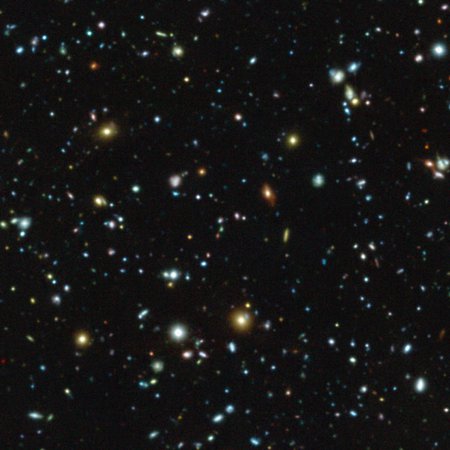Disentangling starlight
Although they look like fuzzy patches of light, distant galaxies are actually made up of billions of stars and other astronomical objects. Telescopes are rarely powerful enough to study individual stars in galaxies except for those closest to the Milky Way, but a team of scientists has now used the MUSE instrument on ESO’s Very Large Telescope (VLT) to resolve the stars in the spiral galaxy NGC 300.
Four hundred years ago, Galileo Galilei became the first person to point a telescope at the sky and prove that the hazy band of the Milky Way is actually composed of billions of individual stars. Astronomy has come a long way since then, and nowadays astronomers do not merely look at the stars, but also analyse their chemical composition, measure their rotation and velocity in space, and determine many other physical parameters to find out more about the Universe — all using a technique called spectroscopy, which is the study of the interaction of matter and light.
Stellar spectroscopy really started taking speed with the emergence of a technique called integral field spectroscopy about 25 years ago. This technique allows astronomers to obtain a 3D view of a galaxy in just one shot. It uses an Integral Field Unit (IFU) to divide the field of view into many segments — or pixels — to obtain a more comprehensive overview of the whole. The signal from each pixel is fed into a spectrograph which generates a light spectrum for each one. The result is therefore a data cube, a sort of "stack" of images, each at a different wavelength. The pixels in this particular case are rather lovingly named “spaxels”.
The integral field spectrographs developed at this time - such as the Potsdam Multi-aperture spectrophotometer (PMAS) [1] - still had a very low number of Spaxels by today's standards. PMAS, for example, only has 256 Spaxels, while a modern mobile phone camera has about 10 to 15 million pixels. A major step forward in 2014 was the installation of MUSE, the multi-unit Spectroscopic Explorer, at ESO's VLT in Chile. The AIP has essentially participated in the development of this instrument. MUSE hosts incredible 90,000 Spaxels and has excellent sensitivity.
Beyond the boarders of the Milky Way
The primary raison d’etre of MUSE is to study the origin and development of the Universe as a whole. As part of the guaranteed observation time available to the MUSE consortium, Martin Roth, department head of innoFSPEC at AIP, requested the use of the new instrument to observe the single stars in the spiral galaxy NGC 300. Similar observations had already been made for nearby galaxies in the so-called Local Group, but not for galaxies farther away - such as NGC 300. Six million light-years from the Milky Way this "typical" spiral galaxy is located outside the Local Group.
Thanks to the powerful instrument and specially developed software [2] [3], the team was able to identify individual stars with high clarity in NGC 300 as well as gaseous regions, supernova remnants, planetary nebulae and ionized hydrogen regions. Even distant background galaxies were faintly visible through the galaxy [4]. MUSE is special because it can look at light with a wide range of wavelengths, making many different objects and colours visible.
Technological plans for the future of exploring galactic past
The scientists hope to be able to observe a variety of stars in detail with other instruments. Under the leadership of the AIP, an international consortium for ESO is currently building the instrument 4MOST, which will enable the spectroscopy of up to 2,400 individual stars per single exposure in the Milky Way. The goal is to study millions of stars in the attempt to unravel our galaxy’s formation history and evolution, as part of a vibrant field of research called “galactic archaeology”.
By analogy with this, working with MUSE in the much further galaxy NGC 300 is paving the way for "extragalactic archeology". The enormous light collection capacity of the future Extremely Large Telescope (ELT) of ESO, combined with the extremely sharp image quality enabled by adaptive optics, promises extraordinarily interesting development prospects for this new field of research [5].
References:
[1] Roth, M.M., Kelz, A., Fechner, T., Hahn, T., Bauer, S.-M., Becker, T., Böhm, P., Christensen, L., Dionies, F., Paschke, J., Popow, E., Wolter, D., Schmoll, J., Laux, U., Altmann, W. 2005, "PMAS: The Potsdam Multi-Aperture Spectrophotometer. I. Design, Manufacture, and Performance", PASP 117, 620
[2] Kamann, S., Wisotzki, L., Roth, M. M. 2013, “Resolving stellar populations with crowded field 3D spectroscopy”, A&A 549, 71
[3] Husser, Tim-Oliver, Kamann, Sebastian, Dreizler, Stefan, Wendt, Martin, Wulff, Nina, Bacon, Roland, Wisotzki, Lutz, Brinchmann, Jarle, Weilbacher, Peter M., Roth, Martin M., Monreal-Ibero, Ana 2016, MUSE crowded field 3D spectroscopy of over 12 000 stars in the globular cluster NGC 6397. I. The first comprehensive HRD of a globular cluster, A&A 588, A148
[4] Roth, M. M., Sandin, C., Kamann, S., Husser, T.-O., Weilbacher, P. M., Monreal-Ibero, A., Bacon, R., den Brok, M., Dreizler, S., Kelz, A., Marino, R.A., Steinmetz, M. 2018, MUSE crowded field 3D spectroscopy in NGC300 I. First results from central fields, A&A 618, A3
[5] An Expanded View of the Universe - Science with the European Extremely Large Telescope, European Souther Observatory, Garching 2010, Hrsg. Mariya Lyubenova & Markus Kissler-Patig
Further information
https://www.eso.org/public/products/brochures/brochure_0025/
Acknowledgements:
The development of the tools PMAS, MUSE, and 4MOST was or is funded by the collaborative research of the Federal Ministry of Education and Research.
Images
NGC 300.
Big screen size [1000 x 625, 870 KB]
Original size [2560 x 1600, 3.8 MB]
Data cube, generated by MUSE.
Big screen size [1000 x 874, 280 KB]
Original size [1208 x 1056, 300 KB]





